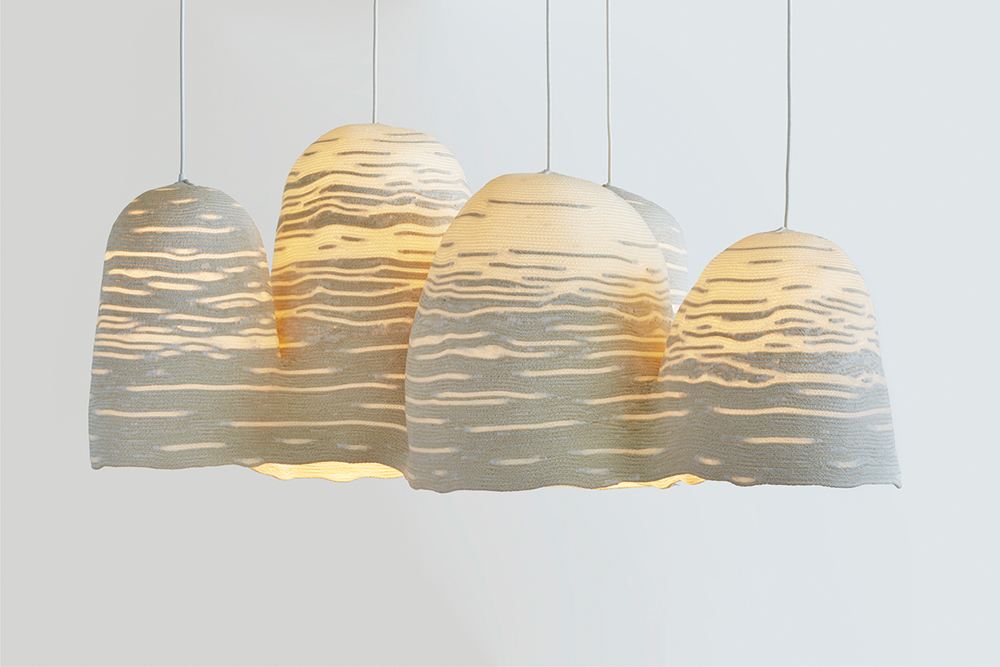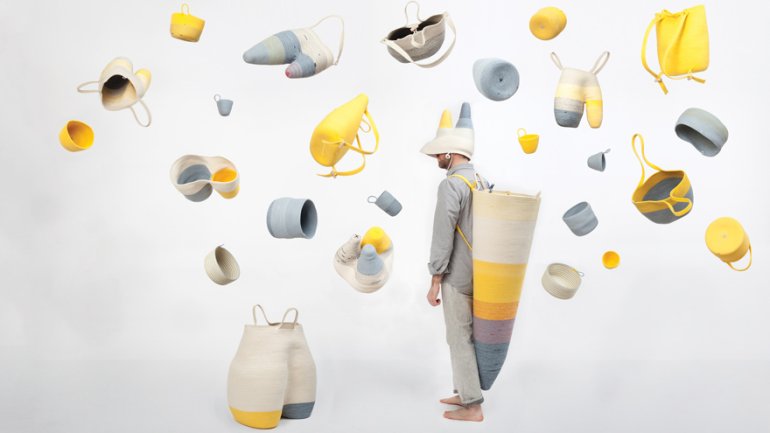Many Splendid Baskets
Many Splendid Baskets
Back before he was an architecture student at Cranbrook Academy of Art, Doug Johnston played drums in a few bands. Always attuned to space and ambience, he sensed that each gig had a unique aesthetic.
“We would play, and there would be a beauty surrounding the night, in the way people were interacting and how the music, performance, and venue facilitated that,” he recalls. It inspired him to imagine how an artist, architect, or designer might craft an experience for social interaction – set the stage with materials and parameters at hand, then let the scene play out. He examined that idea for his thesis project in the mid- 2000s, weaving plastic tubing into giant openwork “nests” in which people could hang out, meditate, converse.
Today Johnston is still making containers that invite contemplation and wonder. His distinctive, highly covetable baskets, bags, and other objects are made of rope that he coils, then binds together on an industrial sewing machine, varying the density of the stitching to help shape the pieces and add surface design. They’re holders for the stuff of daily life: stylish totes and knapsacks, bowls for desktop odds and ends, tubs for books or blankets, hanging sheaths for twigs or dried flowers, pendant lampshades that capture and transform light. Working in a mostly improvisational manner, he’ll often conjoin two or more humps into a clever catchall. Or he’ll invert a vessel into a cover, suggesting a mysterious shrouded form, one that doubles as art object and hiding place. Now and then he’ll break from function entirely and coil oversized or purely sculptural pieces for gallery shows and commissions.

Beyond vessels, bags, and seating, Johnston also makes lighting, such as this 2017 cotton and nylon cord sculpture. Photo: Michael Popp
“One day I’ll be excited about making a straightforward, simple basket. The next day, I’ll want to make something enormous and colorful and complex,” says Johnston, 39, who shares a studio in Brooklyn with his wife and frequent collaborator, designer Tomoe Matsuoka. “I’m like, ‘Am I the same person?’ But this process allows me to explore all my interests.”
He took up his craft in 2010, a few years after he graduated and moved to New York. At the time, he was working for an architectural metalwork company and living with Matsuoka in an apartment above a dollar store. “I loved to go down there and look around. They had these hanks of cotton rope that I was attracted to,” says Johnston, who liked to sew and was already making bags and backpacks. Inspired by the Native American baskets his parents collected in his Oklahoma childhood, he bought a supply of cordage, learned basic coiling from YouTube tutorials, and started evolving his signature style. Design blogs soon took note, orders poured in, and in 2012 his studio work became his full-time job.
Through his combinations of thread with natural cotton and synthetic rope, Johnston makes great use of color. Some works feature subtle beige-and-white expressions, others serene pairings of salmon and beach-glass gray. Then there are his bold statements in fire-engine red and shocking blue.
Ironically, he’s red-green colorblind. “I’ve always been a little apprehensive about my color usage,” he admits. “Purple looks blue to me, and it’s hard to tell if a brown is warm or cool.”
Could his unusual relationship with color be the special sauce in his work? Johnston isn’t sure. “It’s usually a disadvantage in most situations in art and design. I definitely have accepted it,” he allows, “but it’s hard for me to feel like it’s a strength.”
With coiling, however, this thoughtful artist feels on sure ground, part of a continuum of technology over centuries, from prehistoric pottery to the 3D printer he enjoys tinkering with today. “For me, there is in this work a way of understanding the collapse of broad spans of time, and also transcending the gap between idea and object,” he says. “This process has become a tool for me, not just for making things but for looking at the world and asking questions.”




